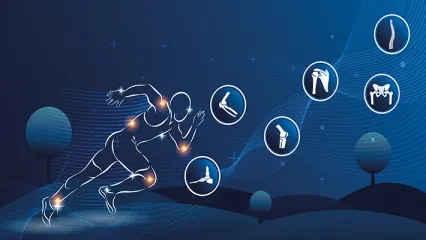Alo Yeditepe
Alo Yeditepe
What Causes Shoulder Dislocation? Shoulder Dislocation Treatment
Orthopedics and Traumatology Specialist Dr. Lecturer Burak ÇAĞRI aksu said that shoulder dislocation is more common in young people and continued his words as follows “Statistics show that young people under the age of 20 who have experienced shoulder dislocation are at risk. The probability of a second shoulder dislocation is 90 percent under the age of 20. Therefore, this age group is important. "If people are over the age of 30, the risk of recurrence drops significantly,"
What is Shoulder Dislocation?
Shoulder dislocation occurs when the upper end of the arm bone (humerus) comes out of its socket (glenoid) in the shoulder joint. As the most mobile joint in the body, the shoulder is at risk of dislocation in individuals of all age groups. Severe trauma, falls, or sports injuries are common causes of shoulder dislocation. In such cases, it is crucial to avoid moving the joint and seek medical attention immediately.
What Causes Shoulder Dislocation?
Shoulder dislocations are among orthopedic emergencies. Orthopedics and Traumatology Specialist Dr. AKSU said that shoulder dislocation can occur in all age groups due to diseases that cause loss of consciousness such as falls, trauma during sports activities, or epileptic seizures. Our specialist explained that in case of a shoulder dislocation, the dislocated joint must first be repositioned and then medically treated, otherwise the dislocation may recur.
What are the Symptoms of Shoulder Dislocation?
Explaining that the most typical symptom of shoulder dislocation is severe pain, our specialist explained that although sometimes a tingling sensation and numbness are experienced in the arm and hand, the pain is so obvious that there is no room for doubt. Orthopedics and Traumatology Specialist gave the following information about the symptoms:
“When shoulder dislocation occurs, the patient immediately applies to emergency services. When comparing the two sides of the shoulder, patients notice a drastic change in its symmetry and the joint is out of place. He also has difficulty moving his arm. The first treatment for shoulder dislocation is to replace the shoulder joint. "We can usually do this in emergency situations, perhaps by giving some relaxing medication, without giving anesthesia."
How to Diagnose Shoulder Dislocation?
Our specialist stated that the first treatment of shoulder dislocation was done in the emergency room and that the patient should not be kept waiting for long hours. He said that shoulder dislocation will cause very severe pain in the patient who is kept waiting for long hours and may affect bone circulation and nerve tissue. Our expert said that in this case, the first treatment that needs to be done is to replace the shoulder joint and continued: “After the first intervention in shoulder dislocation, treatment is planned in the form of physical therapy, surgical treatment or a combination of these, as a result of follow-ups and radiological examinations. "If these are not followed, we may encounter problems such as instability in the shoulder joint, re-dislocation, chronic painful shoulder, and decreased range of motion," he said.
How is Shoulder Dislocation Treated?
Stating that today's treatment is 90 percent closed, that is, arthroscopic surgery, our specialist said, “The complication rate that patients may experience after closed surgery is also lower. However, there are things the patient should pay attention to during this healing process. First of all, physical therapy is definitely required during this process. Depending on the patient's ability, we often find it appropriate to continue with physical therapy. "We will complete the acute recovery period within 4-6 weeks," he said.
Frequently Asked Questions About Shoulder Dislocation
Can I Return to Daily Life Immediately After Shoulder Dislocation Treatment?
Emphasizing that the purpose of surgical treatment is for the patient to be able to use his shoulder stability and return to normal life, our specialist continued his words as follows: “Especially for professional athletes, it is much more important to be able to return to sports again. After the rehabilitation process, an average of six weeks is needed, although it varies from person to person. Afterwards, the return to sports activities is made gradually. After the injury, we cannot expect him to pick up where he left off. After the 6th week, he/she meets with the physiotherapist of the team he/she works for and returns to sports.”
Is Physical Therapy Necessary After Shoulder Dislocation Treatment?
Orthopedics and Traumatology Specialist Dr. AKSU said that certain movements should be performed in patients who have undergone surgery and said, “If we cannot perform these movements, movement restrictions may develop depending on the healing properties of the tissue. "Physical therapy is as important as surgery in operations performed after shoulder dislocation," he said.
Can I Reattach My Shoulder Myself in Case of Shoulder Dislocation?
Our expert explained that some people try to put their shoulder back into place, perhaps under the influence of movies, but this is extremely dangerous, and concluded his words as follows: “When the shoulder comes out, it is necessary not only to put it back into place, but also to continue the treatment afterwards. Trying to position one's own shoulder can be not only painful but also dangerous. Not only does it affect joint health, but it also restricts some activities in his/her life. Even worse, a person may acquire this as a psychological habit. If this situation develops, the chances of success of subsequent surgeries decrease. Therefore, it should never come to this point.”
Does Shoulder Dislocation Recur?
Stating that age is a very important factor in the recurrence of shoulder dislocation, our expert Dr. AKSU said, “Statistics show that young people who have experienced shoulder dislocation under the age of 20 are at risk patients. We see this situation mostly as a sports injury in young people. The probability of a second shoulder dislocation is 90 percent under the age of 20. Therefore, this age group is important. Between the ages of 20 and 30, we do not consider surgery for the first dislocation. We plan physiotherapy specifically for the patient. If a second dislocation occurs, surgery is the primary treatment option in this group as well. The risk of recurrence decreases significantly after the age of 30. "When it happens again, we decide whether surgery is required or whether physiotherapy is sufficient with necessary examinations such as MRI and tomography," he said.
What is Shoulder Dislocation Surgery?
The necessity of shoulder dislocation surgery is determined after a detailed evaluation by a physician. Surgical intervention may be required in cases of recurrent dislocations, damage to ligaments or cartilage caused by dislocations, or when conservative treatments such as physical therapy fail to yield effective results.
The primary goal of the surgery is to stabilize the shoulder joint, prevent recurrent dislocations, and restore the joint’s normal range of motion. Today, this procedure is commonly performed using arthroscopic (minimally invasive) techniques. However, following the surgery, a careful rehabilitation process guided by the physician’s recommendations is essential for a successful recovery.
This content was prepared by Yeditepe University Hospitals Medical Editorial Board.
”
See Also
- What are Hip Joint Diseases? Causes and Treatment
- What is Hallux Rigidus (Stiff Big Toe/Toe Arthritis)? Symptoms and Treatment
- What is Hallux Valgus (Bunion)? How is it Treated?
- Ergonomics in Automobiles Prevents Accidents
- Why Does Ankle Pain Occur? What Is the Treatment?
- Spinal Fractures
- Big Toes Can Be A Big Problem!
- Not Only Athletes Suffer from Meniscus Tears!
- Mistakes While Swimming Can Cause Shoulder Pain
- Myths About Fractures
- Sports Injuries
- Knee Arthritis
- Knee Pain
Alo Yeditepe



